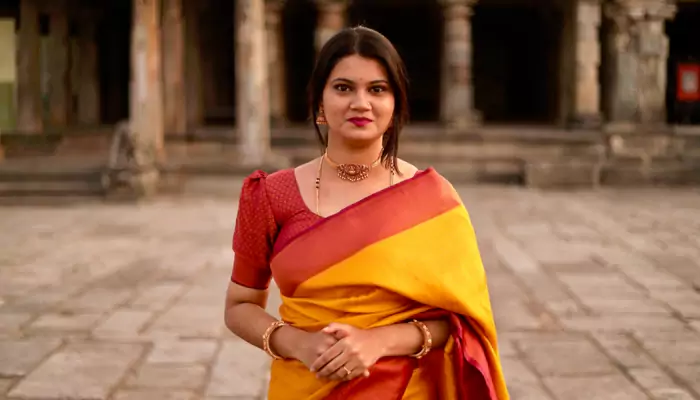Popular South Indian Weaves in Six Yards of Grace
These quintessential South Indian saree types are also wardrobe must-haves!
- Puja Sinha
- 25 March, 2025
- 2 mins ago

Popular South Indian Weaves in Six Yards of Grace
These quintessential South Indian saree types are also wardrobe must-haves!
Saree weaving in South India has ancient roots, dating back to the Indus Valley Civilization. The tradition, nonetheless, flourished and thrived as different dynasties and emperors ruled the lands. In the southern parts of the continent, each region has its distinct style, techniques, and motifs, reflecting the cultural diversity of South India. Today, multiple initiatives warrant the survival and growth of traditional and genuine weaving practices.
Kanjeevaram, A Celeb Endorsed Saree Weave
Kanjeevaram reeks of royalty and timeless elegance. The process of weaving a pure kanjeevaram requires the interweaving of mulberry silk with pure gold and silver zari threads, a task which is being hereditarily done by the Padmasaliyar weaving community. For the designs and motifs, the weavers rely heavily on temple iconography. The detailed and complicated work explains why it takes between two to six months to complete the weaving work. In contemporary times, Kanjeevaram sarees have a more modern appeal with cheques, dots, and stripes to resonate with the younger age groups.

Kasavu, A Cultural Identity of Kerala
The white and gold Kasavu sarees of Kerala are visual elegance; a sight of serenity and calm. The unique aesthetic born by the Malayali community, the cloth is also a part of Dhotis, which is then called Kasavu Mundu. Irrespective of the minimalist look of these sarees, a lot of intricacies go into the making. The colour and thickness of the gold border vary, but the dominant colour remains white.
Madras Cheques, A South Indian Hit
Madras cheque is a lightweight cotton saree woven from cotton yarn and is perfect for the tropical sultry heat. The fabric and weaving have achieved cult popularity and have been seamlessly assimilated into pop culture. Today, to trace the thrive of Madras Cheques across the world is to appreciate the hand-woven fabric with the same pattern on both sides coloured using vegetable dyes, which contribute to a bumpy texture. The fabric has travelled to the US, Africa, and Caribbean Islands to stay and become a local comfort for decades now.
Gadwal Silk Sarees, A Zari Rendezvous
This saree weave features exemplary South Indian zari work. Gadwal sarees are century-old light-weight saree weave from Telangana. Woven beautifully is the cultural richness of Telangana. Silk/cotton and zari are the primary materials needed for the weaving of Gadwal and it has buttas all over as motifs. The vibrant colour palate of Gadwal makes it an easy choice for festive wear.
Pochampally, A Testimony to Zari Brilliance
Pochampally silk sarees are renowned for their bold and intricate geometric patterns with diamonds, squares, and other symmetrical shapes embedded. An illustrious feature of Pochampally sarees is the Ikat dyeing technique. Ikat involves resist-dyeing the threads before they are woven, creating unique and intricate patterns. The saree has its origin in Bhoodan-Pochampally of Telangana from where it has now become a global phenomenon. Typically made from silk or a silk-cotton blend, Pochampally sarees retain a luxurious feel and a natural sheen. The art has been preserved and passed down to several generations professionally engaged in the work.
Konrad, A Matter of Refined Grace
The meticulous weaving of intricate motifs like elephants, peacocks, and temple designs found in Konrad sarees explains its high stature as an art form. Much of the grandeur of Konrad sarees is reflected in the wide and elaborately designed borders that shine with traditional elements. The borders and pallu feature rich zari (gold or silver thread) work, adding a touch of opulence to the attire. These sarees have deep cultural significance and are worn on auspicious occasions to preserve culture and traditions. Browns, greys, and off-whites are the natural and authentic hues.









